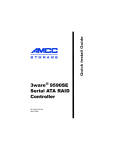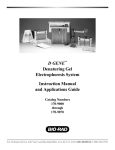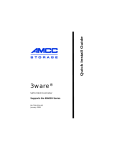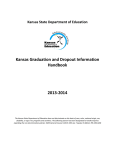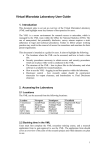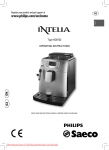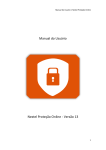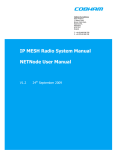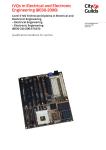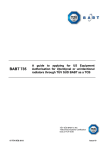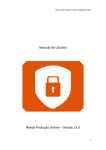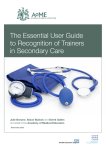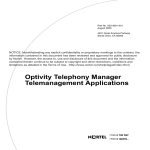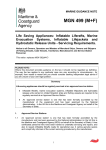Download A Guide to the BABT Implementation of the Marine
Transcript
BABT 740 A Guide to the TÜV SÜD BABT Implementation of the Marine Equipment Directive (96/98/EC) A Certification Body of © TÜV SÜD BABT 2013 Foreword This guide overviews the BABT Implementation of Modules B, D, E, F and G of the Marine Equipment Directive (MED), 96/98/EC. The implementations of Modules D and E are explained in more detail in BABT 791. The implementation of Module F is explained more fully in BABT 741. If you require UK National Approval of a product which is listed in Annex A.2 of the current Amendment of the Directive please refer to BABT 816 which details the requirements for such approval. This guide is designed so that the essential information can be read quickly by reading the main text only. Where you require more information, refer to the appropriate shaded text. The scheme enables a manufacturer of a product within the scope of the MED to affix a Wheel mark including the BABT Notified Body number after satisfying the appropriate module(s) of the MED. The formal requirements of the scheme are set out in the Certification Regulations. All publications are available from: http://www.tuv-sud.co.uk/babt or TÜV SÜD BABT Octagon House Concorde Way Segensworth North Fareham Hampshire PO15 5RL United Kingdom Tel: +44 (0) 1489 558306 Fax: +44 (0) 1489 558101 Guide to the TUV SÜD BABT Implementation of the Marine Equipment Directive BABT 740 Issue 5 Page i of ii Contents 1. Introduction ........................................................................................................................................ 1 1.1 Scope .................................................................................................................................................. 1 1.2 Background ........................................................................................................................................ 1 1.3 Overview ............................................................................................................................................. 1 1.4 TUV SÜD BABT TCB Scope .............................................................................................................. 1 1.5 Approval Options and Modules ....................................................................................................... 2 1.6 Definitions and Terms ....................................................................................................................... 1 1.7 Module B: Type Examination .......................................................................................................... 1 1.8 Module D: Production Quality Assurance ...................................................................................... 2 1.9 Module E: Product Quality Assurance ........................................................................................... 2 1.10 Module F: Product Verification ....................................................................................................... 2 1.11 Module G: Unit Verification ............................................................................................................. 3 2. Making an application for a Type Examination Certificate or a Unit Verification Certificate ..... 3 2.1 2.1.1 2.1.2 How to apply ...................................................................................................................................... 3 Original and Brandname/co-licence applications ............................................................................... 3 Transfer Applications ........................................................................................................................... 3 2.2 Who can apply ................................................................................................................................... 3 2.3 2.3.1 2.3.2 2.3.3 2.3.4 Type of Application ........................................................................................................................... 3 Type ..................................................................................................................................................... 3 Original Applications ............................................................................................................................ 3 Modifications ........................................................................................................................................ 3 Brandname applications ...................................................................................................................... 4 3. Information required on the application form ................................................................................ 4 3.1 General ............................................................................................................................................... 4 3.2 Section A: Applicant Details ............................................................................................................. 5 3.3 3.3.1 3.3.2 Section B : Your Certification requirements. .................................................................................. 5 Marine Equipment Directive Certification............................................................................................. 5 Recognition of Marine Equipment Directive Certificates in North America.......................................... 5 3.4 3.4.1 3.4.2 3.4.3 3.4.4 Section C: Product Details ............................................................................................................... 5 Products Submitted ............................................................................................................................. 5 Product Type ....................................................................................................................................... 6 Number of Production Items ................................................................................................................ 6 Related Products ................................................................................................................................. 6 3.5 Commercial Information ................................................................................................................... 6 3.6 Agreement .......................................................................................................................................... 6 3.7 Annex A .............................................................................................................................................. 6 4. Progressing the Application ............................................................................................................. 6 5. Information to accompany an application ...................................................................................... 7 5.1 General ............................................................................................................................................... 7 5.2 Technical Documentation File Index ............................................................................................... 7 5.3 Purpose of Equipment and identification of equipment ................................................................ 7 5.4 Block Diagram.................................................................................................................................... 7 5.5 Circuit Diagrams and PCB layout Diagrams ................................................................................... 7 5.6 Parts List (Bill of Materials) .............................................................................................................. 7 Guide to the TUV SÜD BABT Implementation of the Marine Equipment Directive BABT 740 Issue 5 Page ii of ii 5.7 Software and firmware Versions ...................................................................................................... 8 5.8 Photographs or Illustrations ............................................................................................................ 8 5.9 Compliance Strategy ......................................................................................................................... 8 5.10 User Instructions ............................................................................................................................... 8 5.11 D of C .................................................................................................................................................. 8 5.12 Manufacturing Test Plan ................................................................................................................... 8 6. Testing and test reports .................................................................................................................... 9 6.1 Introduction ........................................................................................................................................ 9 6.2 Requirements for Test Facilities ...................................................................................................... 9 7. Verification of the test program. ...................................................................................................... 9 7.1 On site testing (Testing outside a Test Organisation site) ........................................................... 9 7.2 Requirements for un-accredited testing ....................................................................................... 10 7.3 Supply of Information ..................................................................................................................... 10 7.4 Compliance Test Plans ................................................................................................................... 10 7.5 Test Reports ..................................................................................................................................... 10 7.6 7.6.1 Aspects of Testing........................................................................................................................... 10 Choice of Samples ............................................................................................................................ 10 8. Certificates and Records ................................................................................................................ 10 8.1 Certificates ....................................................................................................................................... 10 8.2 Records ............................................................................................................................................. 11 9. Activities after the Issue of a Module B Certificate ..................................................................... 11 10. Regulatory Marking. ........................................................................................................................ 11 10.1 10.1.1 10.1.2 Options ............................................................................................................................................. 11 Module B............................................................................................................................................ 11 Module G ........................................................................................................................................... 11 10.2 Wheel Mark ....................................................................................................................................... 12 11. Annual Continuation of the Certificate .......................................................................................... 12 12. Keeping your Type Examination Certificate up to Date .............................................................. 12 12.1 General ............................................................................................................................................. 12 12.2 12.2.1 12.2.2 12.2.3 12.2.4 12.2.5 12.2.6 12.2.7 12.2.8 Authorisation of Changes to Certified Equipment and Certificate Information ........................ 12 General .............................................................................................................................................. 12 Broad Categories of Changes ........................................................................................................... 12 Certified Liaison Engineer(CLE) ........................................................................................................ 13 Changes to product supporting items unrelated to the certified product ........................................... 13 Changes to the Certificate unrelated to the product realisation ......................................................... 13 Changes to aspects of the product covered by other compliance schemes or requirements ........... 13 Changes to the certified product which do not affect conformity to the certification requirements .... 13 Changes to the certified product which potentially affect conformity to the certification requirements covered by the certificate and thus need testing ............................................................................... 14 Changes to the certified product which extend the scope of the certification .................................... 14 Changes to Standards and IMO regulations...................................................................................... 14 Expiry of the Type Examination Certificate ........................................................................................ 15 Charges for processing changes. ...................................................................................................... 15 Documentation to accompany a request for change ......................................................................... 15 12.2.9 12.2.10 12.2.11 12.2.12 12.2.13 13. Changes to Unit Verification Products .......................................................................................... 15 14. 14.1.1 Monitoring by TÜV SÜD BABT ....................................................................................................... 15 Causes for monitoring ....................................................................................................................... 15 Guide to the TÜV SÜD BABT Implementation of the Marine Equipment Directive 1. Introduction 1.1 Scope BABT 740 Issue 5 Page 1 of 15 This guide overviews the TÜV SÜD BABT Implementation of Modules B, D, E, F, and G of the Marine Equipment Directive (MED ,96/98/EC including the latest effective amendment). Furthermore it more fully explains the implementation of Module B (Type examination) and Module G (Unit Verification) of the MED. 1.2 Background The Merchant Shipping (Marine Equipment) Regulations 1999 (SI 1999 No 1957) provide for the "type approval" of marine equipment, of a safety or pollution prevention nature, for use on board United Kingdom ships. This legislation (as amended most recently by the new SI 2009 No 2021) when considered with, MSN 1734 (M+F)), as amended, implements the European Council (EC) Directive 96/98/EC of 20 December 1996) 1.3 Overview The MED provides for a number of alternative routes to meet the requirements of the directive. The routes available for particular equipment are dependent upon the standards.IMO Regulations invoked by the category and nature of the equipment. Refer to either MSN 1734 or the Directive 96/98/EC for full details. Overleaf is a diagram listing the various options and their interrelation. 1.4 TUV SÜD BABT TCB Scope TÜV SÜD BABT is notified to operate modules B, D, E, F, and G (as appropriate) for products listed in Annex A.1 of the current Amendment to the Directive in particular Life-saving appliances, Navigation and Radio equipment, and equipment required under Colreg 72. The schemes to support these operate under the TÜV SÜD BABT Certification Regulations. The current list of products within the scope of TÜV SÜD BABT are listed on our web site at fhttp://www.tuv-sud.co.uk/uk-en/about-tuev-sued/tuev-sued-in-the-uk/tuev-sued-babt/product-certification/marineproduct-certification If you have a product listed in Annex A.1 of the current amendment within in any of the above categories which is not currently listed within our scope please discuss this with us prior to submitting any application. If you require UK National Approval of a product which is listed in Annex A.2 of the current Amendment of the Directive please refer to BABT 816 which details the requirements for such approval. Guide to the TÜV SÜD BABT Implementation of the Marine Equipment Directive 1.5 Approval Options and Modules BABT 740 Issue 5 Page 2 of 15 Guide to the TÜV SÜD BABT Implementation of the Marine Equipment Directive 1.6 BABT 740 Issue 5 Page 1 of 15 Definitions and Terms Manufacturer A manufacturer is the person who is responsible for designing and manufacturing a product with a view to placing it on the Community Market on his own behalf. The Manufacturer has an obligation to ensure that a product intended to be placed on the community market is designed and manufactured, and its conformity assessed to the essential requirements. The Manufacturer must always retain the overall control and have the necessary competence to take responsibility for the product. Authorised Representative The Manufacturer may appoint any natural or legal person to act on his behalf as an Authorised Representative. The Authorised Representative must be established inside the community. An Authorised Representative may be addressed by the authorities of the Member states instead of the manufacturer with regard to the latter’s obligations under this directive. The Manufacturer remains generally responsible for actions carried out by an Authorised Representative on his behalf Importer An importer (a person responsible for placing the product on the market) is any natural or legal person established in the community who places a product from a third country on the community market. The importer must ensure that he is able to provide the market surveillance authorities with the necessary information regarding the product where the manufacturer is not established in the community and has no Authorised Representative in the community. Agent An Agent is a natural or legal person, established either within the community or elsewhere in the world, appointed by the manufacturer to act on his behalf with respect to the application. Where the Agent is not the nominated Authorised Representative the application must include a letter from either the Manufacturer or the Authorised Representative Authorising BABT to communicate with the Agent for matters related to the application. Applicant The applicant must be either the Manufacturer or the Authorised Representative. An Application may not be made in the name of an Agent who is not also the Authorised Representative. Brand Name Application An Application for a Module B or G certificate naming the Brand name Company as the Manufacturer. This application is based on making use of an existing Module B or G Certificate which names the Original Product Manufacturer. Brand name products are normally the same as the original product with the exception of cosmetic difference (e.g. Labels, enclosure colours) and often follow the same production line processes as the original products. 1.7 Module B: Type Examination Under this module a sample of your product is tested for compliance with appropriate standards/IMO Regulations listed for use with the MED (refer to the Amendment of the MED which is in force at the time of application) and a test report produced detailing the results. TÜV SÜD BABT will evaluate this report against the requirements of the standard/IMO Regulation , the requirements of the MED, and correlate this with the build and user information for the product. When TÜV SÜD BABT is satisfied all the necessary requirements are met a Module B Type Examination certificate is issued. Further details of the application requirements and process for Type Examination follow later in this document. Guide to the TÜV SÜD BABT Implementation of the Marine Equipment Directive 1.8 BABT 740 Issue 5 Page 2 of 15 Module D: Production Quality Assurance Under this module you must document and operate a quality assurance system such that all production items falling within the scope of the MED are compliant with the requirements of the MED with their performance traceable to the original tested sample. The formal requirements for the scheme are listed in either MSN 1734 (Annex B) or the MED 96/98/EC including any amendments current at the time of application. The implementation of this Module is described in BABT 791. The assessment standard for this scheme is BABT AP008 BABT PS 340 (Production Quality Certification). For Module D Parts 1, 2 and Annex G of BABT AP008 BABT PS 340 apply. Where you hold an existing Module D Certificate from another Notified Body you may apply to “Transfer” this to TÜV SÜD BABT for some or all your product scopes. Application details for transfers may be made using document BABT 789 (Application for transfer of a MED Module D or Module E Quality Management Certificate to TÜV SÜD BABT). Partial Transfers of Module D It is recognised that under some circumstances a Manufacturer may not wish to transfer all the products listed on a Module D Certificate from the existing NB to TÜV SÜD BABT ( e.g. A product model due to be replaced but remaining in manufacture for several additional months. TÜV SÜD BABT are willing to use the transfer process in cases where the original NB will retain the Module D Certification for certain products and TÜV SÜD BABT take over the responsibility for others. This could enable a staged transfer of products between NBs. Note: A given product should not be listed more than one Module D Certificate ( except during the Hand-over time allowing for different NB Processes. The Declaration of Conformity and Wheelmark for each product must list the NB responsible for the Module D under which the product is produced. Each NB would still have to audit the production facility and meet its obligations for products listed on the Module D certificate which it has issued. Normal Applications for Module D should be made using document BABT 339 (Application for MED Module D (Production Quality Assurance) or Module E (Product Quality Assurance) Certificate. 1.9 Module E: Product Quality Assurance Under this module you must document and operate a quality assurance system relevant for a particular product/ or product range such that all production items in that range which fall within the scope of the MED are compliant with the requirements of the MED with their performance traceable to the original tested sample. The formal requirements for the scheme are listed in MSN 1734 (Annex B) including any amendments current at the time of application. The BABT implementation of this Module is described in BABT 791. The assessment standard for this scheme is BABT AP008 BABT PS 340 (Production Quality Certification). For Module E Parts 1, 2 and Annex H of BABT AP008 BABT PS 340 apply. Where you hold and existing Module E Certificate from another Notified Body you may apply to “Transfer” this to BABT for some or all your products. Application details for transfers may be made using document BABT 789 (Application for transfer of a MED Module D or Module E Quality Management Certificate to BABT). Normal Applications for Module E should be made using document BABT 339 (Application for MED Module D (Production Quality Assurance) or Module E (Product Quality Assurance) Certificate. 1.10 Module F: Product Verification Under this module you identify the number of product items you intend to manufacture within a specified time. A product sampling plan is then agreed under which you will test the sample to an agreed test plan and supply the reports to TÜV SÜD BABT. These are inspected or tested (as appropriate) to ensure they are representative of the original tested products. Obligations remain upon the manufacturer with respect to individual unit inspection and test, product marking, and record retention. The formal requirements for the scheme are listed in MSN 1734 (Annex B) including any amendments current at the time of application. Details of this scheme are provided in document BABT 741. Guide to the TÜV SÜD BABT Implementation of the Marine Equipment Directive 1.11 BABT 740 Issue 5 Page 3 of 15 Module G: Unit Verification This module is only suitable for single or very small numbers of production items. Each unit is examined and tested by the notified body for compliance to the standards and MED requirements. It is similar to the Type Examination module but since each item is examined has no requirement for production controls. Note: Prior to applying for a Module G Certificate you should check the compliance options for your Item Type as Module G is not a valid option for certain item types. A Module G Certificate constitutes a Certificate of Conformity and permits the wheel mark to be affixed on products. Further details of the application requirements and process for Unit Verification follow later in this document. 2. Making an application for a Type Examination Certificate or a Unit Verification Certificate 2.1 How to apply The application is an order for TÜV SÜD BABT’s certification services and should be made direct to TÜV SÜD BABT in Octagon House . Applications will be accepted by post, or email, to [email protected] Regular Customers of TÜV SÜD BABT may request an FTP upload address as an alternative to e-mail or post but must advise customer service when an application is fully uploaded. 2.1.1 Original and Brandname/co-licence applications The application must be made using form BABT 775 and must be accompanied by the required information to support the assessment. On receipt of your application, TÜV SÜD BABT will generate and send you a confirmation of the application. 2.1.2 Transfer Applications The application must be made using form BABT 806 and must be accompanied by the required information to support the assessment. On receipt of your application, TÜV SÜD BABT will generate and send you a confirmation of the application. A transfer application may either be made for a stable product or as a part of a Modification to an existing 2.2 Who can apply Applications can be made by manufacturers or Authorised Representatives of equipment under the MED. Normally the person making the application should be a duly authorised signatory of the applicant . Applications may also be made in the name of the manufacturer by an Authorised Representative or suitably authorised Agent. Please note the Certificate will be issued listing the applicant company as holder. For Module B Certificates related applications for Modules D,E, or F have to be made in the name of the Module B Certificate holder. 2.3 Type of Application 2.3.1 Type The application should be made for either Type Examination (Module B) or Unit Verification (Module G). Applications may be made for either Original Certificates, Transfers of Module B from another NB, Modifications to existing Certificate, or a Certificate for Brand names of products. 2.3.2 Original Applications The main information in this guide applies to applications for original certificates. 2.3.3 Modifications Please refer to the section “Keeping your Type Examination Certificate up to date for specific information related to Modifications. For Modification to Brandname products please also refer to the following section. Guide to the TÜV SÜD BABT Implementation of the Marine Equipment Directive BABT 740 Issue 5 Page 4 of 15 2.3.4 Brandname applications Brand name products are normally the same as the original product with the exception of cosmetic difference (e.g. Labels, enclosure colours) and often follow the same production line processes as the original products. Brandname applications may only be made where a substantial amount of the testing applied to the original product still applies to the Brand name. ( e.g. A Brand name product may have a different housing which would require additional EMC testing, but should not vary in functionality or key characteristics) . Where there are any technical differences TÜV SÜD BABT reserve the right to require a brand name application be re-classified as an original application with original supporting data. Note: TÜV SÜD BABT will not accept an application for a Brandname of a product unless we are the NB responsible for the Module B for the original product. Where a product is being transferred at the same time as a you are making an application for a new Brandname you should make separate applications and advise TÜV SÜD BABT Where a brandname product is being transferred at the same time as the original product you must ensure that the application is made by a party ( Manufacturer or Authorised Representative) who is responsible for each brandname certificate. An Application for a Technical modification to a Brandname which is not also applied to the Original product may result in the link to the Original product being broken such that future test results cannot be read across from the original product. A Brandname application must be accompanied by the following: A statement of the differences between the original product and the Brandname product Where some differences are not cosmetic o A justification for using test data from the original product o Additional relevant testing for the technical differences Where the Original product was not tested to the versions of the relevant standards current at the time of application for the Brandname certificate then either (or a selection of both) : o A justification showing the previous test results meet the requirements of the current issue of the standard; or o Testing to the updated standard (entirely or in part) Where there are multiple Brand names, test results from other Brand names to the latest standard may be used provided there is evidence that permission from that holder has been given ( It will not in this instance be presumed even if the original holder is an agent for both) Where you have appointed an Agent a letter from the Manufacturer appointing them The original Manufacturer may be appointed to act as the agent of the Brand name manufacturer. This may be beneficial where original and Brand name applications are made in parallel as the same person is authorised to make a response to common concerns in several applications. Where the Original Manufacturer is not the Agent of the Brandname holder then a letter from the original Certificate holder authorising the use of their test and technical date in support of the Brandname application. (Agents who are the Original Manufacturer are assumed to authorise themselves). Either o A copy of the Brandname User manual; or o A statement that the only changes (if any) to the Original Holder User manual will be changes related to the Product name and manufacturer. Any of the other items required for original application where they differ significantly with that of the original product. 3. Information required on the application form 3.1 General In general TÜV SÜD BABT require the same information for all types of application. Please refer to BABT 775 or BABT 806 (for transfers) when reviewing this section. Guide to the TÜV SÜD BABT Implementation of the Marine Equipment Directive 3.2 BABT 740 Issue 5 Page 5 of 15 Section A: Applicant Details Section A.1 identifies the person within the organisation with whom TÜV SÜD BABT will communicate. The Company name and Address are used as the address for the Certificate. Where you are an Authorised Representative applying under your own company name it is MANDATORY that you provide full contact details of the manufacturer including a contact name within the manufacturers company. This information must be part of the application. Where you are a manufacturer established outside the Community it is recommended that you appoint an Authorised Representative within the community. Where an Authorised Representative has been appointed please provide full contact details of the Authorised Representative on headed paper from the manufacturer. You may identify a consultant/agent to act on your behalf who is not formally appointed as an Authorised Representative. TÜV SÜD BABT require that you include a formal letter appointing the Agent (on headed paper and signed by an responsible person within the applicant company). Note: TÜV SÜD BABT will require this for every instance you send in an application and do not assume that an authorised agent for one application is authorised for another. While TÜV SÜD BABT will accept legal power of Attorney appointments we do not require these. 3.3 Section B : Your Certification requirements. 3.3.1 Marine Equipment Directive Certification For Type of Assessment and Type of Application refer above. For Unit Verification (original applications or Transfers with Modification) we require to know the location where this will take place. Where you select Test Laboratory and TUV Product Service at Titchfield is the choice please just identify this with the application. For all “Other Locations” and Test Laboratories please provide the full postal address. 3.3.2 Recognition of Marine Equipment Directive Certificates in North America Where you wish to also market the product in the USA you may require a US Coast Guard (USCG) number. Please indicate as appropriate if you wish TÜV SÜD BABT to allocate/obtain this. For certain Navigation products we are able to allocate this number under the terms of the MRA (Council Decision 2004/425/EC). Otherwise TÜV SÜD BABT is able to request the number from USCG making use of the Module B Certificate and supporting information. Transfers Where an EU NB has issued the US Coast guard Number under the MRA a new number must be issued citing the TÜV SÜD BABT NB number and Certificate number. Where either Transport Canada or the US Coast Guard have issued the number on the basis of an existing Module B they must be advised of the transfer. TÜV SÜD BABT can issue the asppropriate notification where requested by you. Where you wish to also market the product in Canada you may require acceptance from Transport Canada Please indicate as appropriate if you wish TÜV SÜD BABT to obtain this making use of the Module B Certificate and supporting information. Note: Where TÜV SÜD BABT allocates a number under the MRA there is no fee; otherwise an appropriate additional fee will be applied to cover the necessary work. Where FCC and Industry Canada Approval is required, separate applications for these may be made using the appropriate forms/mechanism. (See web site for details). 3.4 Section C: Product Details 3.4.1 Products Submitted This information is normally used to identify the product on the certificate. TÜV SÜD BABT will check this information with other identifying information within the application; any unexplained differences will cause delays in certification. Guide to the TÜV SÜD BABT Implementation of the Marine Equipment Directive BABT 740 Issue 5 Page 6 of 15 3.4.2 Product Type Please identify the product type of your equipment after making reference to the list of types of product at the start of this document. TÜV SÜD BABT is only appointed for certain types of products. If your type of product does not appear on the list please contact the TÜV SÜD BABT Certification Manager in advance of the application to make sure that we are able to progress the application. For some products it is helpful if you provide additional information to assist us in understanding the scope of the certification. Please provide this information either on the form, or in a separate document. 3.4.3 Number of Production Items Please provide this estimate. 3.4.4 Related Products If your product is derived from one for which you currently hold a TÜV SÜD BABT Certificate and you wish to make use of any of the previous data please indicate this and provide the Certificate number related to that product While this could reduce the assessment time we will need a clear justification within the Technical file for the use of the earlier results. Likewise for Brandname products or applications covering more than one model we require details of the differences between the models Note: Where an application covers more than one model TÜV SÜD BABT may charge an additional portion of our fee for assessing the additional model(s). 3.5 Commercial Information Please complete this information. Clients who do not currently have approved credit facilities must include a completed Credit Details Form with the application. Alternatively payment in advance is accepted. The appropriate forms may be downloaded from www.tuv-sud.co.uk/babt. 3.6 Agreement This forms the contract with the Certification body. It must be completed and signed on or on behalf of the applicant. Normally it is signed by the listed main contact. 3.7 Annex A This section is intended as a brief checklist of possible contents of a Technical File sent with the application. It is not mandatory that this annex be completed or included with the application form does not have to be included Refer later for more details on the contents of a technical file. 4. Progressing the Application When TÜV SÜD BABT has received your application and evaluated the initial information, we will: ask you to pay an application fee. The fee relates to the assessment of the application. Where you have identified a specific contact to whom to send the invoice it will be sent to them; otherwise it will be sent to the main contact; inform you of the reference number assigned to your application. This number should be quoted in all further correspondence; review your application for completeness and consistency; Where information is missing from an application or the reviewing Engineer raises a query further work on that application will be suspended at an appropriate time and will only be resumed after the response. Where TÜV SÜD BABT is satisfied we will formally issue the Type Examination Certificate or Unit Verification Certificate (as appropriate). We will advise you when this occurs; If there is a significant shortfall which either cannot be remedied, or where the remedy is not submitted in a timely fashion TUV SÜD BABT may dismiss the application. Note: If additional testing is required TÜV SÜD BABT will expect to be advised when this is due for completion; Each certificate will detail the applicant, product identity(ies), and standards complied with; the certificate annex will detail information relevant technical information and the identities of the test reports. Each Original Certificate has a validity of 5 years from the time of issue. Transfers Certificates will retain the expiry date of the original certificate unless a full re-certification review has been performed. Guide to the TÜV SÜD BABT Implementation of the Marine Equipment Directive 5. Information to accompany an application 5.1 General BABT 740 Issue 5 Page 7 of 15 You should submit a Technical Documentation File to accompany the application. This file shall contain all the necessary information to evaluate compliance to the requirements and to record the build status of the product in sufficient detail to ensure later verification against product supplied against that certificate. The application supporting documentation should be submitted electronically as Adobe PDF, MS-Word, or jpg files (as applicable) in the required directory/folder structure. Documentation identification and Issue status All documents submitted electronically should be clearly named to indicate their purpose and contents. Documents submitted in paper format should be identified by document number and issue status (e.g. Issue number or date); For multi-page documents each page should hold such information and a page number indication. 5.2 Technical Documentation File Index Where there are multiple similar files or the purpose of individual files is not immediately evident it is recommended that you provide an index to the information to assist with the review process. 5.3 Purpose of Equipment and identification of equipment For multipurpose equipment, or systems where the functions are split between specific apparatus it is helpful if you include an expanded description of each item (Note: Extracts of sections of the supplied User Manual are not required.) Where you are seeking a certificate including more than one model we need clear information identifying each model and the differences between models. 5.4 Block Diagram You should include a block diagram showing the following dependent upon the complexity of the apparatus. points of connection to other apparatus, power sources, and antenna(s) any other radio/wireless interfaces indicators of key functionality connections to earth (protective or functional) For radio devices a diagram showing the frequency of all oscillators in the apparatus. For complex equipment with switching capabilities, include a cross connection matrix showing the possible connections through the equipment between the various ports and/or terminating stations, if relevant to the assessment The provision of a block/circuit diagram is essential to help ensure that all parties quickly reach a common understanding of the relevant tests and certifications required The block/circuit diagram should be accompanied by a brief technical description explaining how the equipment interacts with the communications networks concerned. 5.5 Circuit Diagrams and PCB layout Diagrams Detailed circuit diagrams and PCB layout diagrams are required for all circuits which may have an effect on conformity. Circuit Diagrams and PCB layout Diagrams must show all network or radio interface circuits, active speech processing devices, hybrids and transducers, line signalling components, power supplies, ports and all network-affecting circuit elements including any components providing user isolation. Circuit elements need only be shown in sufficient detail to explain the above. Circuit diagrams should match up with the actual samples submitted for certification. 5.6 Parts List (Bill of Materials) Parts lists for those areas of circuit detail identified in the circuit diagrams and data sheets for any Radio Critical component. Parts List: Critical tolerances should be identified where applicable and the manufacturers of safety-critical Guide to the TÜV SÜD BABT Implementation of the Marine Equipment Directive BABT 740 Issue 5 Page 8 of 15 components, all transducers and components affecting the signal path, including all second sources, should be stated. If more than one source of a critical component (e.g. line interface IC) is to be used, samples from all sources should be submitted for assessment 5.7 Software and firmware Versions The version of any software and firmware supplied with the apparatus which may affect compliance with the certification requirements must be declared. Software : Where the relevant software is installed separately from the hardware (e.g. device drivers in PCs) then installation conditions must be provided either as a part of the software installation package or in the user guide. Where special software is provided to enable testing, then the version of such software must be recorded with a clear statement about the relationship of this software to the production sample. 5.8 Photographs or Illustrations Photographs or illustrations showing the external features of the complete equipment are required where the user instructions/supplied Installation instructions do not include this information. 5.9 Compliance Strategy You should include details of the compliance strategy. This should include details of the Standards and IMO regulations related to this product; and any limitations in applicability of standards or tests that have been used. 5.10 User Instructions You should supply (in English) a draft or published set of User Instructions, and where relevant Installation Instructions. For complex equipment you may only include the sections of the user instructions relating to the compliance of the equipment with the standards and IMO regulations rations. User Instructions should contain all the information for installation, use and maintenance required for conformance to the relevant standards, and should not give details of adjustments which can take the equipment outside compliance - unless it is made clear how to adjust the equipment to maintain compliance and that any non-compliant setting would invalidate the certification. The presence of user instructions at the earliest stages of assessment, even if in draft form, will give you the best possible chance of an accurate test schedule being written rapidly and a smooth assessment. If the User guide does not provide photographs or illustrations showing the external features of the complete equipment, this shall be provided separately. 5.11 D of C You should include a draft (or actual) Declaration of Conformity to Type within the Technical Documentation File. The format of the declaration include all the relevant information as specified in MarED 01-016 (Gen-008). 5.12 Manufacturing Test Plan Where you plan that the production phase of the product will be under a Module D certificate issued by TÜV SÜD BABT we require that you provide either: A manufacturing Test Plan highlighting in particular the production tests which ensure the manufactured product complies with the relevant requirements of the Directive; or A reference to an existing agreed Manufacturing test plan with a justification of its relevance to the current product. Manufacturing Test Plans These may be generic documents for certain item types, or specific for a given product realisation. They should indicate the tests and pass-fail criteria, and any specific test equipment requirements ( e.g. calibration, use of “just-fail . While TÜV SÜD BABT do not require that this plan is separate from normal production documentation it must be under the control of the Certificate Holder. Where it is produced in a local language TÜV SÜD BABT require that the compliance critical tests are translated/re-produced in English. The Manufacturing Test plan/justification is reviewed and agreed during the review of the Technical Data. Guide to the TÜV SÜD BABT Implementation of the Marine Equipment Directive 6. Testing and test reports 6.1 Introduction BABT 740 Issue 5 Page 9 of 15 The Technical Documentation File must include a test report showing compliance with the appropriate standard. The test report must come from an acceptable source of test reports. 6.2 Requirements for Test Facilities TÜV SÜD BABT normally requires that the test reports are issued by a test laboratory accredited by UKAS or another national accreditation body where the scope of accreditation includes the required test report. Where there is no laboratory with the required standard within its scope, or where there is a clear justification for making use of an unaccredited test facility which is not recognised by TÜV SÜD BABT you should contact us prior to commissioning testing. TUV SÜD BABT Recognised Test Facility (RTF) List. TÜV SÜD BABT maintain a list of test facilities recognised by them for use within our certification schemes. This list includes externally accredited Test Laboratories and non accredited facilities which have demonstrated they meet the essential requirements of ISO/IEC 17025 (or equivalent) to TÜV SÜD BABT. Details of acceptable sources of Test Data and RTF listing may be found in document BABT 766. This document may be found on the BABT Web site : http://www.tuv-sud.co.uk/babt 7. Verification of the test program. Where you opt to test at TÜV SÜD and advise them of the intent of applying to TÜV SÜD BABT for a certificate we will allocate a TÜV SÜD BABT Certifier to confirm the commissioned testing is sufficient to demonstrate the compliance. Where you choose another test facility you may request that TÜV SÜD BABT check the test program but will have to authorise the Test Laboratory to communicate with us, and to supply all supporting information. 7.1 On site testing (Testing outside a Test Organisation site) Where you require on-site testing then you should advise TÜV SÜD BABT of the site where the equipment may be tested/inspected. You should confirm whether the Testing organisation is suitably accredited/recognised to perform such tests outside their normal location. If your selected Testing organisation does not hold suitable accreditation for testing outside their laboratory site you must request they identify the process by which they will ensure the validity of their intended testing and provide such to TÜV SÜD BABT in advance of the commencement of testing. TÜV SÜD BABT will advise you whether we require to witness some or all of the testing. (Note: There will be an additional charge where this is necessary). Where you are applying for Unit Verification and it is impractical to send the unit(s) for test at a test facility you should advise TÜV SÜD BABT of the site where the equipment may be tested/inspected. Observation Testing: Certain standards require specific display information. Manufacturers may with the agreement of TÜV SÜD BABT perform such tests at their own facility. The Results of the observation/inspection tests should be recorded in an appropriate report listing the requirements with compliance information. The report shall also include full evidence (e.g. Photographs) of a sample of the tests. We will reserve the right to request evidence of other selected tests. Declarations Where a standard permits compliance to a requirement be declared, or where TÜV SÜD BABT have agreed to accept such in lieu of test the Declaration must be made on company headed paper and signed by a person suitably qualified to make the declaration. Guide to the TÜV SÜD BABT Implementation of the Marine Equipment Directive 7.2 BABT 740 Issue 5 Page 10 of 15 Requirements for un-accredited testing Where you perform testing at a location (or on your own site) which is unaccredited for the particular test in addition to agreeing the location with TÜV SÜD BABT prior to the start of testing you shall: Where you have tested using the test methods invoked in the standards make a statement confirming this in the report Where you have used any test method not specified in a standard provide details of the test method followed (either in the report or separately) Provide details of the competence of the person performing the test ( e.g. experience/training/qualification) Provide details of test equipment used and the calibration status of the equipment Provide Measurement Uncertainty values for critical tests 7.3 Supply of Information We recommend that you supply as much of the supporting information for your product to your test facility as early as possible, preferably with a copy of your application to TÜV SÜD BABT. This will assist in the preparation of test plans and early identification of any differences within the documentation (e.g. Product Names, revision status). 7.4 Compliance Test Plans Where you have not previously tested and submitted a type of product to TUV SÜD BABT we recommend that you discuss your compliance test plan with us in advance of commissioning the testing. This will reduce the risk of under or over testing and may assist in the evaluation of the submitted technical documentation. 7.5 Test Reports The test report(s) must follow the requirements for test reports included within ISO/IEC 17025 clause 5.10 . Where the build level of the sample tested differs from that for which certification is sought the Technical Documentation File must include a justification that the test results are representative of the build level listed in the application. Related Products: Where the application (or set of applications) covers a range of related products the test reports shall be sufficient to cover the range taking into consideration the supporting documentation of similarity between products. Where differences in implementation could affect particular requirements testing to those requirements should take place on sufficient variants to cover each different implementation. 7.6 Aspects of Testing 7.6.1 Choice of Samples You may submit a pre-production sample for testing if assessment is required before a production model is ready. Where you are applying for certification for a range of models you should discuss with the test facility and/or TUV SÜD BABT how best to minimise the amount of testing required (and so limit the cost) by choosing a representative model or models from the range for the full programme of tests. However, in this situation more than others, close co-operation and detailed technical information are required in order to make the right choice. In certain cases, it may be necessary for the facility to see models other than the representative model(s), for identification and specific tests. For example, equipment which is electrically identical with a representative model but which has a different casing may require testing of the electrical, mechanical or acoustic properties of that casing. Pre-production samples: Such a sample should be technically identical with the proposed production model except for minor substitute features. Examples are: fabricated parts for which moulding or castings are planned handmade items which will eventually be fully tooled differences in appearance, colour and arrangement of keys. 8. Certificates and Records 8.1 Certificates Module B and G Certificates are issued with a 5 year expiry date and comprise of a front certificate sheet and an associated annex. The following information is listed on the Certificate and Annex Guide to the TÜV SÜD BABT Implementation of the Marine Equipment Directive 8.2 BABT 740 Issue 5 Page 11 of 15 Applicant Company name and Address Manufacturers Company name and Address if different from the applicant Reference to the MED Product Type according to Annex A1. Product Name and Model identification (and for Unit Verification the serial numbers/unique identity of each item covered by the certificate) Date of Certificate Issue and Expiry TUV SÜD BABT Notified Body Number (i.e. 0168) Standards to which the Product demonstrated compliance List of Documentation reviewed by the NB ( e.g. Test Reports, User Information , Build Information) Name of any identified Authorised Representative Conditions of Validity Name and Signature of person within the Notified Body issuing the Certificate Records TÜV SÜD BABT maintains records of all the details on a certificate; of each submission and the resulting evaluation for 10 years after the last significant file activity. The Manufacturer or his Authorised representative is required to maintain records the records defined in Module B (or Module G for Unit Verification) of the Directive for 10 years. 9. Activities after the Issue of a Module B Certificate The issue of a Module B Certificate does not of itself give you the right to apply the wheelmark on a product and market it within Europe. The product must also meet the production /verification requirements under either A Module D Certificate A Module E certificate A Module F Certificate. TÜV SÜD BABT do not presume that you will follow any particular route. Where you wish to use one of the above under TÜV SÜD BABT you should review the appropriate guide and apply separately to cover your product by that route. If you are using another NB for the production phase then you should advise them of the issue of the Module B Certificate and follow their process. TÜV SÜD BABT will only list a stand-alone Module B Certificate on MarED where a clear justification is given. 10. Regulatory Marking. 10.1 Options 10.1.1 Module B Module B must always be paired with either Module D, E, or F. The product may only be marked with the Wheel mark by a manufacturer in possession of a pair of certificates covering Module B and one of the others. 10.1.2 Module G Module G is a standalone option. Accordingly the Wheel Mark may be applied to units covered by the Module G certificate. Guide to the TÜV SÜD BABT Implementation of the Marine Equipment Directive 10.2 BABT 740 Issue 5 Page 12 of 15 Wheel Mark The Wheel mark in respect of the Directive shall be applied only to equipment for which a valid Certificate of Conformity and Declaration of Conformity exists. This shall be followed by number of the Notified Body who have issued the Certificate covering the selected production conformity module and a year indication. The BABT notified body number is given in the example below. The yy should be replaced by the last 2 digits of the year in which the wheel mark was placed on the product. (i.e It must change each year) . The formal definition and size constraint of the mark are given in MSN 1734 Annex C. 0168 yy 11. Annual Continuation of the Certificate There is no annual fee for the continuation of either a Module B (Type examination) or Module G(Unit Verification) certificate. However modifications to certificates are charged for in line with the resource required to progress the change. 12. Keeping your Type Examination Certificate up to Date 12.1 General Over the lifetime of a product and the supporting certificate, TÜV SÜD BABT understands that it is likely that you will want to make a number of changes. Review each change: Whilst not all changes will be significant to the certification, each change, however small must be considered for its potential effects and their relevance to the certification and conformance to the relevant IMO regulations and the standards listed for that item type in the Amendment of the Directive current at the time of the change. 12.2 Authorisation of Changes to Certified Equipment and Certificate Information 12.2.1 General Changes may be authorised by one of the following dependant on the category of change TÜV SÜD BABT or a TÜV SÜD BABT-appointed Certification Liaison Engineer (CLE) or the Holder acting on their own responsibility 12.2.2 Broad Categories of Changes Changes to product supporting items unrelated to the product certification. This include such items as packaging, warranty cards, cabling for non-certified ports Changes to the Certificate unrelated to the product realisation (e.g. Address of Holder) Changes to aspects of the product solely covered by other certification schemes or requirements Changes to the certified product which are believed not to have potential to affect compliance to the requirements covered by the certificate Changes to the certified product which potentially affect the compliance to requirements covered by the certificate and thus need testing Changes to extend the scope of the certification (which may or may not entail changes to the product) Changes to Standards Changes to the Referenced Marine Equipment Directive Amendment Expiry of the Type Examination Certificate Guide to the TÜV SÜD BABT Implementation of the Marine Equipment Directive BABT 740 Issue 5 Page 13 of 15 12.2.3 Certified Liaison Engineer(CLE) You can nominate one of your own engineers or one of your manufacturer’s engineers as a CLE. This optional facility is a powerful feature of the scheme as it permits a fast track for some product changes while maintaining the integrity of the certification. When appointed by TÜV SÜD BABT, the CLE acts on our behalf to assess design changes and component changes where these changes are within the scope of the authorising authority given to the CLE. Full details of the CLE scheme are given in BABT 731. 12.2.4 Changes to product supporting items unrelated to the certified product Frequently the scope of the certification is less than the whole supplied product. Packaging, information sheets, cables for uncertified ports, and adapters often form a part of the finished manufactured product but are not usually relevant to the certification. These are normally not submitted as part of the product to be certified. Items outside the scope of the certified product are not subject to any TÜV SÜD BABT control. 12.2.5 Changes to the Certificate unrelated to the product realisation All changes to the name, or address of the Holder or the Authorised Representative must be advised to TÜV SÜD BABT. We will review the Change and if satisfied that the integrity of the Certification remains will up-issue the Certificate. Normally for such changes the Expiry date of the Certificate, and referenced Amendment to the Directive will remain the same as the previous issue. Note: It is the responsibility of the Holder to identify every instance of Certificate which is affected by a change( e.g. Module B, Module D and C of C Certificates.) Where a Holder or Manufacturers Company name changes within the same legal company registration this may be advised simply by a known contact from within the company. Note: For changes to the Certificate Holders Name the supporting DofCs must be up-issued in the new name. Where the responsible company for the product is changed within a corporate structure ( e.g. Divisions being split into separate companies, or responsibility for the product is moved} then a new application must be made for a certificate in the new company name . We advise you to discuss the implications of such a change on current Module B and Module D Certificates as soon as possible. If a product is sold outside the corporate structure then a new application must be made. If a company becomes a part of a larger corporate structure this does not require to be advised to TÜV SÜD BABT unless there are consequential changes to the Company name, or underlying controls. 12.2.6 Changes to aspects of the product covered by other compliance schemes or requirements Where the product has aspects of design necessary to comply with mandatory or optional requirements from other schemes, then changes within that area of design which do not impinge on an area covered by a TÜV SÜD BABT certification( e.g. FCC where BABT has acted as the TCB) , may be made without redress to ourselves. Regulatory requirements: Certificate holders are required to maintain compliance with regulatory and legal requirements pertaining to their certified products at all times. 12.2.7 Changes to the certified product which do not affect conformity to the certification requirements Where a CLE has been appointed, changes which are within the scope of his/her authority will be assessed using the change control procedure agreed at the time of their appointment as a CLE. The CLE may authorise the change without involving BABT. Where a CLE has not been appointed, you must send full details of changes to BABT for authorisation. If, exceptionally, TÜV SÜD BABT determines that testing is necessary, you will be advised. You may then negotiate directly with the test laboratory concerning the test work to be performed. Modifications to embedded software: TÜV SÜD BABT may accept modifications to software, which is stored in memory within the certified product, provided that you can give an assurance that the new version does not affect conformance to the relevant standards and is uniquely identified. If we determine that testing is necessary you will be advised. Guide to the TÜV SÜD BABT Implementation of the Marine Equipment Directive BABT 740 Issue 5 Page 14 of 15 12.2.8 Changes to the certified product which potentially affect conformity to the certification requirements covered by the certificate and thus need testing Where a change to the certified part of a product requires testing TÜV SÜD BABT must authorise the change to enable the certification to be maintained. You should either send full details of the changes and any supplementary information in duplicate to your test laboratory (with an instruction to forward one set with the completed test report) , and a copy of the covering letter; or send two duplicate packages one to your test laboratory and one to TÜV SÜD BABT. The letter to should indicate your intended test facility. In both cases it is your responsibility to ensure the resulting test report is sent to TÜV SÜD BABT. When testing is required, you are not obliged to use the original test laboratory but may use any Test facility which meets the requirement for the original testing. Version of standards to be used for Testing: Testing must be performed using the latest version of the Standard. Where a standard has been replaced in its entirety this must be discussed with TÜV SÜD BABT. Where only partial testing to a given standard is performed the application for the modification must include a justification for the partial testing, and a review of any results obtained from a previous version of the standard demonstrating their compliance to the current version. Where the change has been tested using standards listed on the Certificate the Certificate Annex may be upissued without changing the Certificate front page, or altering the expiry information. 12.2.9 Changes to the certified product which extend the scope of the certification Such changes must be advised to BABT prior to commissioning any testing. TÜV SÜD BABT will determine whether this change may be progressed as above for “changes which potentially affect the conformity”, or whether a new Certification is required. Where TÜV SÜD BABT determines a new Certification is required the product will be subject to the set of requirements ( including Standards Issue) current at that time. Test Data obtained related to the original Certification may be used if still valid. In such instances a “new” Module B Certificate would be issued with a new expiry date. Where you extend the functionality of the product invoking differing standards, then you must obtain a “new” certificate. 12.2.10 Changes to Standards and IMO regulations Where a standard which is listed on your Type Examination Certificate is up-issued you are required to establish compliance with the new version . While it is understood standards may have implementation dates and dates of withdrawal of previous versions the expectation is that you will request an up-issue of your TEC to list the new version within a reasonable time from the new issue. Note: The version of the standard is often checked at the time of the commissioning of new equipment on-board vessels so it is advisable to list the current version as soon as possible. On occasion up-dates to IMO resolutions come into effect before the Standards body has up-issued the supporting standard. Where this occurs we recommend that you discuss this with TÜV SÜD BABT to establish a route wherein the latest version of the IMO resolution may be listed on the TEC. In all the above cases where full testing to the latest requirement has not taken place the application for the modification must include a justification of why the results obtained using the previous version of the standard are sufficient to demonstrate compliance to the relevant clauses of the current issue. Guide to the TÜV SÜD BABT Implementation of the Marine Equipment Directive BABT 740 Issue 5 Page 15 of 15 12.2.11 Expiry of the Type Examination Certificate If you wish your certificate to be renewed you must present TÜV SÜD BABT with a full set of test data to a set of standards current at the time of the expiry. Where you use test reports obtained for the original certification it must be accompanied with a justification for its use with for the renewal. You may either provide a completely new pack of supporting information, or a statement of the relevance of the previous documents to the current product. TÜV SÜD BABT will perform a full re-assessment of compliance before up-issuing the Certificate with a further 5 years validity. It is understood that some purchasers of equipment require that the TEC has a minimum of 6 months validity as a condition of purchase. As such you may at any time request a full re-assessment and up-issue of the expiry date Note: For early re-assessments the new expiry date will be 5 years from the date of the re-certification decision and NOT an additional 5 years from the existing Certificate issue. 12.2.12 Charges for processing changes. In general charges are related to the amount of work required to perform the review and issue of documentation. Where a complete review is required the standard fee for a new application will be made. 12.2.13 Documentation to accompany a request for change You may advise TÜV SÜD BABT of a planned change to a product (or change requiring a variation to the Certificate) by e-mail, or letter to Customer Service citing your Certificate number. You must accompany this request with relevant information related to the type of change. 13. Changes to Unit Verification Products In general since Certificates of Conformity based upon Unit Verification deal with a very limited number of units changes after the certificate is issued are not expected. However should a situation arise where changes are required then the details of the change should be made to TÜV SÜD BABT who will assess whether any technical verification is required. A Fee appropriate to the effort involved will be invoiced. Should additional unit items be required after the certificate has been issued a new application should be made. This may however refer to relevant details of the original application. 14. Monitoring by TÜV SÜD BABT 14.1.1 Causes for monitoring Under the MED the Notified Body who issued the Certificate of Conformity have the primary responsibility for the Approval. If TÜV SÜD BABT receives any complaints or significant concerns about a product for which TÜV SÜD BABT has issued a TEC we shall note the concern and forward the information to the Notified Body who issued the Certificate of Conformity. TÜV SÜD BABT will not progress any Changes or extension of Certification for that product until the issue is clarified by the Notified Body who issued the Certificate of Conformity.






















